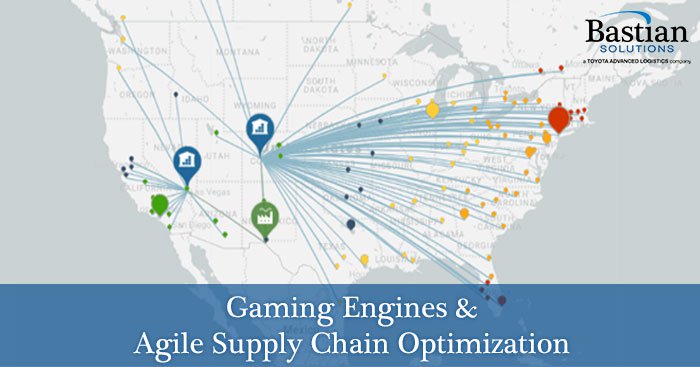
Using a Gaming Engine for Agile Supply Chain Optimization
Michael Walters | 12 May 2020
The pressure from consumers for better service, price and product value seems to be one of the only constants companies can count on in today's rapidly evolving global market, with fulfillment time at the forefront of these expectations.
Initially ignited by Amazon Prime's promise of two-day shipping, companies now face the daunting reality that acceptable delivery times for online orders will soon be measured by hours rather than days. In this environment, the efficiency and responsiveness of a company's supply chain is paramount to profitability and success. For companies to meet these expectations, supply chain optimization software has quickly made the transition from luxury to necessity.
Supply Chain Optimization Software
Although the landscape and applications for supply chain optimization may have changed, the fundamentals of the software and methodologies being used remain relatively the same. Engineering software providing black-box solutions loaded with all the bells and whistles imaginable have continued to dominate the network design market. These offerings have become extremely powerful and feature rich. However, this can also lead to increasingly expensive, complex, time-intensive and inflexible software packages.
For a network study using one of these software packages, the typical duration from project initiation to final recommendation is often around three to six months.
Think about that for a moment…the current industry standard for network studies takes a quarter to half of a year just to finish the initial study, model and recommendation. This does not even account for the additional time required after the study has concluded for the client to process the recommendation, develop a project roadmap and implement changes.
A Faster, More Responsive Option
Considering the rate at which demand changes and technology evolves, companies cannot afford to take this many months or even years to reach an "optimal" supply chain network. By the time the recommendation is finally proposed and implemented, the model could be partially or entirely obsolete. So how do you mitigate the risk of a network model becoming obsolete? Be agile. Mimic this trending software development method that focuses on the power of quick design iteration and responsiveness to change and apply those principles to network design.
One option that focuses on agility and disrupts the supply chain software market is from a company called Starboard. Starboard’s Navigator aims to reinvent supply chain design and avoid the common hurdles of high price tags and steep learning curves while still providing a robust solution to typical problems like route optimization, warehouse selection, inventory optimization, 3PL selection, seasonal strategies and more.
What Starboard Can Do
Starboard is a web-based client-server platform that relies on cloud computing and a “gaming simulation engine” to solve supply chain problems quickly and efficiently. By embedding engineering and optimization best practices into the business rules engine, time is saved by not having to create and configure logic and constraints from scratch. By focusing on modeling agility and what it calls "triage-iteration", Starboard pushes the envelope on expected development time by claiming the following:
- One hour to get a close answer and understand what should and should not be in a model
- One day to get a good answer and understand the sensitivities— what drives your particular optimization
- One or two weeks to work with your organization to reach consensus on an action plan
Starboard focuses on having an interactive user interface that was designed to be simple, intuitive and visually appealing. It also utilizes up-to-date reference data like truckload, LTL, ocean, air, and labor indexes as a key component in its architecture to ensure lane rates and facility costs are accurately captured.
Some of the common logistics questions clients using Starboard are trying to answer would be:
- Where should my next warehouse(s) be located?
- What are the impacts and implications on my network if volume grows by X%?
- What is the optimal number of fulfillment locations are required to serve my customer in X days? And where should they strategically be located?
- Can supply routes be optimized in my existing network to reduce transportation costs?
- What would be the impact on transportation cost and service time if I reduced the number of fulfillment locations? Or changed suppliers?
Starboard embraces the notion that the goal of a network design tool is not to predict the future, but rather to help make an informed decision. A quote by George Box often referenced by Starboard states: "All models are wrong, but some are useful." No matter how much money is paid for software or time spent developing a network model, it can never be 100% accurate. However, by embracing agility and operational responsiveness in supply chain modeling, you can give yourself the best opportunity for successfully navigating the ever-changing market landscape.
If you’re interested in learning how your operations can be improved using tools like network studies or supply chain modeling, contact us.
To learn more about Starboard, visit their website: https://starboardcorp.com/
Michael is a Consulting Engineer with Bastian Solutions out of Chicago, IL. He works with clients to analyze and evaluate their current processes to identify critical areas of operational improvement and recommend innovative solutions to help them meet their strategic business goals. Michael received his B.S. degree in Industrial Engineering from Purdue University and his M.S. degree in Industrial Engineering from Georgia Institute of Technology.
Comments
No comments have been posted to this Blog Post
Leave a Reply
Your email address will not be published.
Comment
Thank you for your comment.